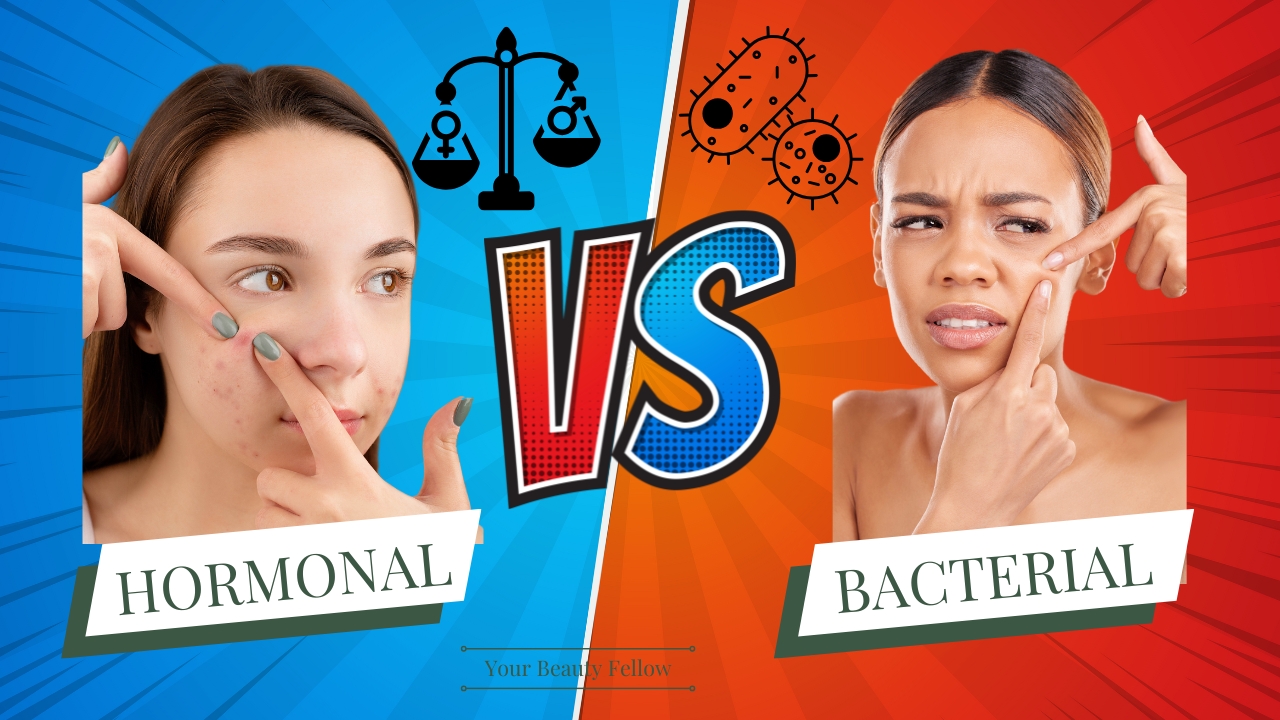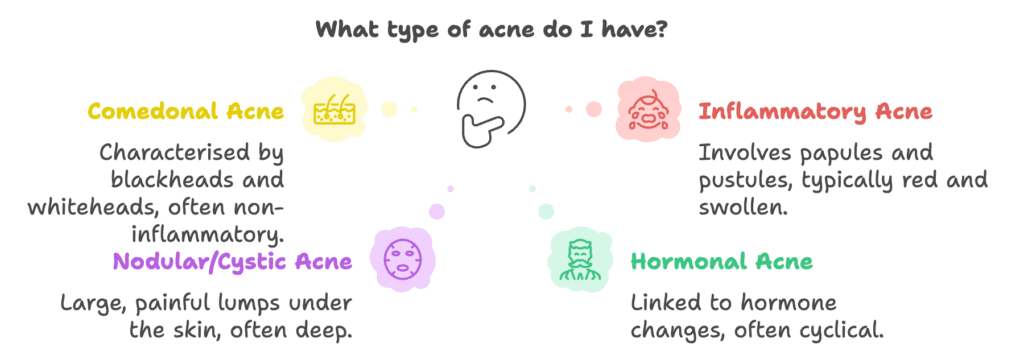
Acne is a complex skin condition influenced by numerous factors, including hormones, bacteria, lifestyle, and skincare routines. For those struggling with persistent breakouts, understanding whether acne is hormonal or bacterial is essential to creating an effective treatment plan. This article will guide you through how to distinguish and treat hormonal and bacterial acne effectively: including the type of acne you’re dealing with, their causes, and tailored solutions using AI tools and the CLEAR Skin Framework.
What Is Hormonal Acne?
Hormonal acne is driven by fluctuations in hormones such as androgens, which can increase sebum production and inflammation. It typically affects:
- Age Groups: Teenagers, young adults, or women undergoing hormonal changes (e.g., pregnancy, menstruation, menopause).
- Areas of the Face: The lower face, jawline, and chin are common regions.
- Symptoms: Deep, painful cysts or nodules, often accompanied by whiteheads or blackheads.
Causes of Hormonal Acne:
- Puberty: Increased hormone levels during adolescence.
- Menstrual Cycles: Fluctuations in estrogen and progesterone.
- Polycystic Ovary Syndrome (PCOS): Elevated androgen levels.
- Stress: Triggers cortisol, which can aggravate acne.
What Is Bacterial Acne?
Bacterial acne occurs when Cutibacterium acnes (C. acnes) bacteria proliferate in clogged pores, leading to inflammation and pus formation. It usually:
- Appears as: Red, inflamed pimples or pustules with a white or yellow center.
- Affects: The T-zone (forehead, nose, and chin) or other oily areas.
- Severity: Varies from mild papules and pustules to severe nodular or cystic lesions.
Causes of Bacterial Acne:
- Excess Sebum: Overproduction leads to clogged pores.
- Dead Skin Cell Build-Up: Blocks hair follicles.
- Environmental Factors: Pollution and dirt aggravate acne.
- Skincare Habits: Using comedogenic products or inadequate cleansing.
How to Identify Your Acne Type

Distinguishing between hormonal and bacterial acne can be challenging. Use these tips to identify your type:
- Track Flare-Ups: Hormonal acne often follows a cyclical pattern, while bacterial acne can occur consistently.
- Location: Hormonal acne affects the lower face; bacterial acne may appear anywhere but favors oily zones.
- Consult AI Tools: Apps like Skin Tracker can analyse photos of your skin to help classify your acne type.
- Consult a Dermatologist: A professional can confirm the type through examination or tests.
Treatment Strategies for Hormonal and Bacterial Acne

Treating Hormonal Acne
1. Topical Retinoids: Stimulate skin turnover and prevent clogged pores.
2. Oral Medications:
- Birth Control Pills: Regulate hormones.
- Spironolactone: Reduces androgen levels.
3. Diet and Lifestyle Adjustments:
- Reduce dairy and sugar intake.
- Incorporate stress management techniques.
Treating Bacterial Acne
1. Benzoyl Peroxide: Kills acne-causing bacteria and reduces inflammation.
2. Salicylic Acid: Exfoliates and unclogs pores.
3. Antibiotics:
- Topical options (e.g., clindamycin) or oral antibiotics (e.g., doxycycline).
4. Double Cleansing: Removes excess oil, sunscreen, and makeup.
Applying the CLEAR Skin Framework
The CLEAR Skin Framework provides a systematic approach to managing acne:
1. Classify Your Skin Type:
Use AI tools like Skin Scanner to determine your skin type and acne type.
2. Learn Your Skin Needs:
- Hormonal acne requires hormone regulation and anti-inflammatory products.
- Bacterial acne needs antibacterial and exfoliating solutions.
3. Establish SMART Skin Goals:
Set realistic expectations, such as reducing acne lesions by 50% in three months.
4. Assemble a Personalised Routine for Hormonal and Bacterial Acne:
Skincare Routine for Hormonal Acne
Hormonal acne often results in deep, painful breakouts. The routine focuses on regulating sebum, calming inflammation, and addressing hormonal imbalances:
Morning Routine:
- Cleanse: Use a gentle, non-stripping cleanser (e.g., with niacinamide).
- Treat: Apply a product with azelaic acid to calm inflammation and reduce redness.
- Protect: Use an oil-free, non-comedogenic sunscreen.
Evening Routine:
- Cleanse: Double cleanse if wearing makeup or sunscreen; otherwise, use a salicylic acid cleanser.
- Treat: Apply a topical retinoid (e.g., adapalene) to promote skin turnover.
- Moisturise: Use a lightweight, hydrating moisturiser with ceramides.
Skincare Routine for Bacterial Acne
For bacterial acne, the focus is on reducing bacterial growth and unclogging pores:
Morning Routine:
- Cleanse: Use a benzoyl peroxide-based cleanser to eliminate acne-causing bacteria.
- Treat: Apply a topical antibiotic (e.g., clindamycin) if prescribed or a spot treatment with salicylic acid.
- Protect: Finish with a broad-spectrum sunscreen suitable for acne-prone skin.
Evening Routine:
- Cleanse: Use a gentle cleanser with glycolic acid for mild exfoliation.
- Treat: Apply benzoyl peroxide or a sulphur-based spot treatment on active pimples.
- Moisturise: Use a non-comedogenic moisturiser to support the skin barrier.
Which Types Are Hormonal ANd Bacterial Acne?
Hormonal Acne:
- Nodular acne and cystic acne are primarily hormonal. These deep, painful breakouts are triggered by fluctuations in androgen levels.
- Learn more: Nodular Acne Solutions | Cystic Acne Solutions
Bacterial Acne:
- Blackheads, whiteheads, papules, and pustules are more likely influenced by bacterial factors, though they can overlap with hormonal causes.
- Learn more: Blackhead Removal Guide | Papules and Pustules Explained
It’s important to note that while acne types can lean toward hormonal or bacterial causes, acne is often multifactorial. Combining treatments to address both root causes ensures a comprehensive solution.
5. Review and Track Your Progress:
Use an acne tracker to monitor improvement and refine your routine.
Prevention Is Key
- Maintain a Healthy Diet: Reduce inflammatory foods and increase omega-3s.
- Manage Stress: Incorporate activities like yoga or meditation.
- Avoid Triggering Products: Check for comedogenic ingredients in skincare and makeup.
Realistic Timeline for Clearer Skin
Clearing acne is a journey:
- First Month: Expect mild improvements.
- Three Months: Noticeable reduction in breakouts with consistent treatment.
- Six Months: Clearer skin and improved texture.
Your Emotional Well-Being Comes First

Dealing with acne, especially severe cases, can take a toll on self-confidence. Join supportive communities, such as Reddit Skincare, to connect with others facing similar challenges. While anecdotal advice can be helpful, remember that your skin is unique. Personalising your treatment plan is essential.
Understanding the difference between hormonal and bacterial acne is crucial to finding the right treatment. Combining AI tools and the CLEAR Skin Framework ensures a tailored, systematic approach to achieving clearer skin. By identifying your triggers, implementing evidence-based treatments, and tracking your progress, you can regain control over your skin and your confidence.
Frequently Asked Questions
What Are the Main Differences Between Hormonal and Bacterial Acne?
Hormonal acne is typically triggered by hormone fluctuations, appearing as deep, painful cysts on the lower face, jawline, and chin. It’s most common during puberty, menstruation, and hormonal changes. Bacterial acne, caused by C. acnes bacteria, presents as red, inflamed pimples with white or yellow centres, primarily affecting the T-zone and oily areas of the face.
How Can I Determine If My Acne Is Hormonal or Bacterial?
Identify hormonal acne by its cyclical nature, location on the lower face, and connection to hormonal changes like menstruation or stress. Bacterial acne tends to be more consistent, appears in oily areas, and responds to antibacterial treatments. AI skin tracking tools and professional dermatological consultation can help definitively classify your acne type.
What Are the Most Effective Treatments for Hormonal Acne?
Effective treatments for hormonal acne include oral contraceptives, spironolactone to reduce androgen levels, topical retinoids to prevent clogged pores, and lifestyle modifications like stress management and dietary changes. Treatments focus on regulating hormones, reducing inflammation, and controlling sebum production.
How Do Treatments Differ for Bacterial Acne?
Bacterial acne treatments target bacteria and inflammation through benzoyl peroxide to kill acne-causing bacteria, salicylic acid to unclog pores, topical or oral antibiotics, and consistent double cleansing. The focus is on reducing bacterial growth, controlling oil production, and preventing future breakouts.
Can Acne Be Both Hormonal and Bacterial?
Yes, acne is often multifactorial. Many breakouts involve both hormonal and bacterial components. Hormonal changes can increase oil production, creating an environment that promotes bacterial growth. A comprehensive treatment approach addressing both hormonal imbalances and bacterial proliferation is often most effective.
How Long Does It Take to See Improvements in Hormonal or Bacterial Acne?
Typically, you can expect mild improvements in the first month, noticeable reduction in breakouts within three months, and significantly clearer skin by six months. Consistency in treatment, using the CLEAR Skin Framework, and addressing underlying causes are crucial for seeing long-term improvements.
Are There Natural Ways to Manage Hormonal and Bacterial Acne?
Natural management strategies include maintaining a low-inflammatory diet, managing stress through techniques like meditation and yoga, staying hydrated, getting adequate sleep, and using non-comedogenic skincare products. While these can help, they should complement medical treatments for more severe or persistent acne cases.






